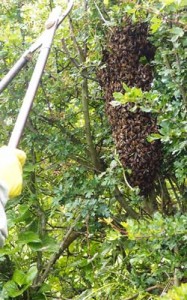Swarms of bees
Are you experiencing some nuisance swarms of bees in your property or garden? If so an essential first step is to identify the insects as your next step will depend upon what they are. Warwick and Leamington Beekeepers can help with swarms of honey bees, but not bumblebees, wasps or honey bees which have already set up home.
Most beekeepers may make a charge for removal of a swarm from your garden, to cover their expenses and costs of petrol etc.
Please note that the County (Warwickshire County Council) do have an advice line regarding insect pests. However the advice they give will be similar to what follows. The County do not employ pest controllers and should you need such a service, they will refer you to outside contractors.
The following pictures will help you identify the insects:
Find a Swarm Collector Near You
If you have a swarm of honey bees (Right hand picture). These may be hanging from a shrub, or tree, or clinging to a post and will have recently arrived. Please contact one of your nearest volunteer Swarm Collectors, using your postcode.
Very importantly, if you have wasps, bumble bees or honey bees which have established a nest in or on your property, the matter is not urgent and taking effective actions rather than urgent ones will save you time and possible expense in the long run.
If you still need further guidance in identifying your nuisance insects please refer to the additional information on the British Beekeepers' Association website.
Having identified the insects, please note the following advice very carefully:
Honey Bees
If honey bees have established their nest in your roof or chimney etc, they have been there for at least several days and they are a nuisance, then Warwick and Leamington Beekeepers cannot help you as we cannot normally get bees out of buildings or confined spaces. You will need to call a commercial pest controller. When honey bees establish a nest, they will remain - usually for several years - if not eradicated.
Please note that whilst honey bees are endangered, they are not protected in law. Sometimes when established colonies are a danger or may damage property, there is sadly no alternative but to eradicate them.
Wasps
Wasps are likely to nest in your roof, in compost heaps, under sheds etc. They are very yellow in colour. If their presence is inconvenient or potentially dangerous, they will need eradication by a commercial pest controller. Please appreciate, though, that only queen wasps survive the Winter in hibernation, the rest of the colony will die out. If wasps can be tolerated until October/November, they will die out and probably not return to the same location - there is no need to incur expenditure to eradicate them if they are not dangerously located.
Bumble bees
Bumble bees are of two broad types of which one is the common garden Bumble Bee, which nests low down, in the ground, in compost heaps etc. These colonize in much lower numbers than honey bees or wasps and only the queen bumble bees survive, in hibernation, over the winter. Should the nest be in an unsafe or inconvenient location, a commercial pest controller should be called, but they are best left alone if possible as the colony will die out in August.
The other broad type of bumble bee is the Tree Bumble Bee, which naturally nests in holes in trees, but now commonly in soffitts behind gutters or in blue-tit boxes. They have a distinctive characteristic of hovering and darting around their entrance hole throughout the day-time. Most colonies in soffitts can be left to die out in August as can those in blue-tit boxes if they are not in an inconvenient location. Whilst a commercial pest controller can be used for Bumble bees in bird-boxes, it is more economical to wait until nightfall when all the bees are in their nest, close up the entrance hole using duct tape or the like, move the box out of harm's way e.g. into a hedgerow, then remove the tape. The box can be collected when all the bees have gone by late Autumn.






